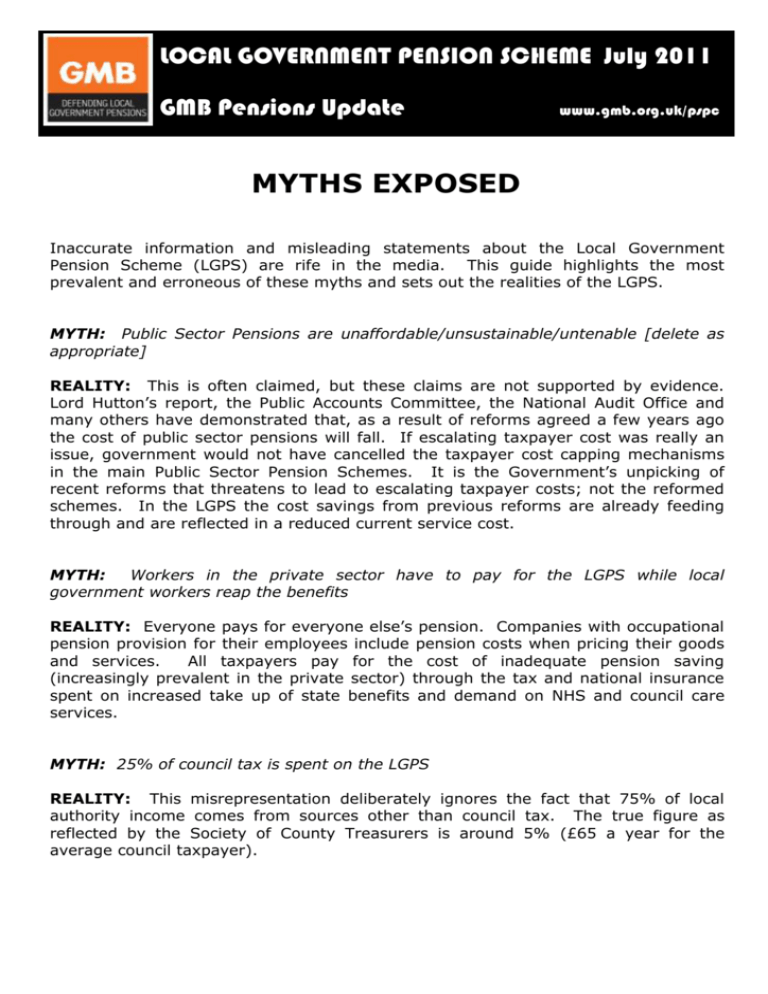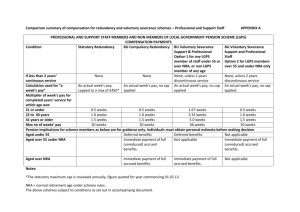Inaccurate information and misleading statements about the Local
advertisement

LOCAL GOVERNMENT PENSION SCHEME July 2011 GMB Pensions Update www.gmb.org.uk/pspc MYTHS EXPOSED Inaccurate information and misleading statements about the Local Government Pension Scheme (LGPS) are rife in the media. This guide highlights the most prevalent and erroneous of these myths and sets out the realities of the LGPS. MYTH: Public Sector Pensions are unaffordable/unsustainable/untenable [delete as appropriate] REALITY: This is often claimed, but these claims are not supported by evidence. Lord Hutton’s report, the Public Accounts Committee, the National Audit Office and many others have demonstrated that, as a result of reforms agreed a few years ago the cost of public sector pensions will fall. If escalating taxpayer cost was really an issue, government would not have cancelled the taxpayer cost capping mechanisms in the main Public Sector Pension Schemes. It is the Government’s unpicking of recent reforms that threatens to lead to escalating taxpayer costs; not the reformed schemes. In the LGPS the cost savings from previous reforms are already feeding through and are reflected in a reduced current service cost. MYTH: Workers in the private sector have to pay for the LGPS while local government workers reap the benefits REALITY: Everyone pays for everyone else’s pension. Companies with occupational pension provision for their employees include pension costs when pricing their goods and services. All taxpayers pay for the cost of inadequate pension saving (increasingly prevalent in the private sector) through the tax and national insurance spent on increased take up of state benefits and demand on NHS and council care services. MYTH: 25% of council tax is spent on the LGPS REALITY: This misrepresentation deliberately ignores the fact that 75% of local authority income comes from sources other than council tax. The true figure as reflected by the Society of County Treasurers is around 5% (£65 a year for the average council taxpayer). LOCAL GOVERNMENT PENSION SCHEME July 2011 GMB Pensions Update www.gmb.org.uk/pspc MYTH: LGPS costs are soaring and the scheme is unsustainable REALITY: The cost of the LGPS to employers for service from April 2008 (2009 in Scotland and Northern Ireland) was reduced during the reforms to the scheme that included changed benefits and higher average member contributions. It is now 13.5% for future service and is set to fall year on year. This cost to taxpayers is lower than other public sector schemes and is significantly below the 17% cost of defined benefit schemes in the private sector. In contrast, member contributions increased in the new schemes to almost 6.6% now standing 0.8% above the old schemes’ member contribution rates. The introduction of cost sharing in the new scheme was designed to cap the future taxpayer share of any changes in costs. Costs associated with service before the new scheme was introduced should have been funded by employers in the past. These costs cannot be reduced by changing the scheme for current or future members. MYTH: Local government pensions are paid directly by the taxpayer REALITY: The LGPS, like all private sector defined benefit schemes, is a funded scheme with real investments in UK and overseas business and tangible assets such as property all generating returns to the 101 funds that make up the Local Government Pension Scheme in the UK. The taxpayer funds a proportion of the employer contribution to the funds through local and national taxation. The fund which currently holds more than £155bn of real assets has sufficient resource to pay the pensions due for at least the next 20 years. MYTH: The employer contribution rate in the LGPS is too high REALITY: There is not one employer contribution rate in the LGPS. There are over 7,000 participating employers in the scheme and each has their contribution set by the private sector actuary employed by the relevant one of the 101 funds in the UK. Current recommended employer contribution rates based on the last actuarial valuation in 2010 range from 11% to 37% with an average of 20%. Of this 20%, an average of 6.1% goes towards paying off the historic deficits that have arisen. This legacy of past underfunding by employers remains in many, although not all, funds so additional deficit payment contributions are still required. MYTH: The LGPS is only nominally funded REALITY: The LGPS has more than £155bn in real assets: property, investments in UK and overseas businesses, cash and government bonds. Four out of the largest 20 pension funds in the UK measured by asset level are Local Government Pension LOCAL GOVERNMENT PENSION SCHEME July 2011 GMB Pensions Update www.gmb.org.uk/pspc Funds. Total income to the scheme exceeds expenditure by £4-5bn every year, even in the current climate of poor economic performance. Even in the depths of the recession LGPS investments provided nearly £3bn for the LGPS in England alone, accounting for 27% of that scheme's income. Another factor contributing to the ongoing viability of the scheme to this is the increase in member contributions built into the 2008 reforms. Yield from employees has increased by 17.5% as a result of the new contribution rates. Indeed, despite the global financial situation some funds have managed to improve their funding levels over the last three years as a result of previous reforms. MYTH: Scheme members retire on gold-plated pensions, protected for life REALITY: Around half of LGPS pensions in payment are below £3,000 a year. The mean average pension is £4,200pa with the average for women only £2,800pa. The coalition Government’s decision to link pension increases to CPI rather than RPI has effectively resulted in a reduction to the accrued rights and expectations of many LGPS pensioner and non-pensioner members. As a result of the 2010 Emergency Budget LGPS members are likely to lose a quarter of the value of their pensions over the next 25 years from this one change alone. This will only serve to push many more on to welfare benefits in old age. MYTH: High earners in the LGPS receive unreasonably high pensions REALITY: In local government highly paid employees are in the same pension scheme as the workers near the minimum wage. In the private sector many company directors and senior managers set up their own exclusive defined benefit schemes on extremely generous terms while their employees have only a low value defined contribution scheme. The average accrued pension for a director in the private sector is £227,726pa, 56 times higher than the average LGPS pension. Some members of the LGPS retire on very high pensions as a result of receiving very high salaries (236 local government employees earn more than £142,500pa), not as a result of an over-generous pension scheme. MYTH: Local government workers have a job for life and better pay than everyone else REALITY: The average length of membership in the pension scheme is less than ten years in stark contrast to the vision of a job for life. Existing jobs are often part time and low paid with minimal opportunity for overtime and other mechanisms common in the private sector to boost income. When comparing full time workers who are saving for retirement through an occupational pension scheme, public sector workers LOCAL GOVERNMENT PENSION SCHEME July 2011 GMB Pensions Update www.gmb.org.uk/pspc actually earn £22 per week less than their private sector comparators. The 'total reward figure', which is gross pay and employers' pension contributions, in the private sector is £666 and in the public sector is £644 per week. Local government pay is also low in the public sector context with two thirds of local government workers earning less than £21,000 a year. MYTH: To make pensions fair public sector provision must be reduced to the level common in the private sector REALITY: This would increase the number of older people forced to live in poverty which in turn will increase the cost to the taxpayer of state benefits, health and care services. It is never the right solution to inequality to stoop to the level of the lowest common denominator. In education the solution to problem of good schools and bad schools is not to worsen the good schools so all children are poorly educated. In pensions the solution is not to worsen the good schemes but to raise the standard of the inadequate schemes. In fact defined benefit pension provision in the private sector attracts a future service employer contribution of 17% compared with 13.5% in the LGPS. MYTH: LGPS benefits need to be cut or member contributions increased because of deficits in the funds REALITY: The LGPS is more than 80% funded with sufficient assets to pay all pensions due for the next 20 years without any further contributions. Where deficits exist they relate to past service and underfunding by employers. One reason for current deficits is that LGPS funds were between 1990 and 1993 encouraged by the then Conservative government to fund only to 75% so the pension scheme could fund lower Poll Tax bills. Now deficits are measured against a 100% funding requirement, the cost of this historic underfunding is clear. Changes to benefits will only affect the future service cost which, as set out above, is already below the private sector average for defined benefit provision. The 3.2% increase in member contributions announced by George Osborne in October 2010 will not improve the scheme’s funding level. Quite the reverse. The additional income will pass through the scheme to the Treasury as employer contributions to the LGPS are reduced by the same amount as the increase in employee contributions (£1.04bn). This money is being deducted from council and devolved budgets thereby reducing the income to the majority of LGPS employers. LOCAL GOVERNMENT PENSION SCHEME July 2011 GMB Pensions Update www.gmb.org.uk/pspc MYTH: The current economic situation means member contributions to the LGPS need to be increased REALITY: Benefits already earned by members have to be paid, whatever changes are made to the scheme or member contribution rates. The tax the Treasury is proposing to introduce on LGPS members will price many out of the scheme resulting in fewer contributions going into the fund in terms of contributions and a reduction in UK pension saving. The collapse in participation rates that will occur if the £1 billion tax is levied on LGPS members as outlined by Treasury and DCLG will mean that the savings the contribution increase is supposed to yield will fail to do so. The fall in income will further mean that the LGPS will quickly move from having a annual cash flow surplus of £4bn to a deficit, causing more problems for local authorities and council taxpayers. Members are currently subject to a three year pay freeze, without the protection for the lowest earners that exists in other parts of the public sector. Some members of the LGPS earn only 37p an hour above the minimum wage. GMB research shows that already 25% of council workers opt out of the LGPS for reasons of affordability, and in some local authorities around half of the workforce has opted out of pension saving. Further research shows that the Treasury’s tax on pension saving will have disastrous consequences, with 50% or more of current LGPS members likely to opt out if this policy is implemented. MYTH: The balance of contributions between taxpayer and employee is unfair so LGPS contributions should increase. REALITY: The cap and share mechanism that this Government has stopped would have limited the taxpayer contribution in the future. The effect of the Osborne Pension Tax in the LGPS will be that many members are paying more into the scheme than their employers. MYTH: LGPS members retire at 60 and get a pension for nothing REALITY: The normal retirement age in the LGPS is 65 and has been for decades. Members of the scheme currently contribute between 5.5% and 7.5% of earnings depending on salary, averaging over 6.5% overall. This is already more than double the amount the average member of a defined contribution scheme contributes. Applying the 3.2% increase the Chancellor outlined in the Comprehensive Spending Review, and protecting the lowest paid, could mean some members’ contributions more than double to 20% while even those on moderate salaries e.g. £22,000 could have to find an extra £100 a month in order to stay in the scheme. LOCAL GOVERNMENT PENSION SCHEME July 2011 GMB Pensions Update www.gmb.org.uk/pspc MYTH: The new LGPS only affects new starters while existing members have their own preferential scheme REALITY: Reforms to the LGPS affected all contributing scheme members, existing and new. The LGPS is not a two tier scheme, the LGPS 2008 (2009 in Scotland and Northern Ireland) is the scheme for any one of the two million people working in LGPS covered employment whether they started ten years ago, ten minutes ago or are due to start tomorrow. Existing members sacrificed benefits and increased their contributions in order to keep the scheme sustainable. The LGPS is the largest pension scheme in the country with more than two million contributing members, one million deferred members and a further one million pensioner members. MYTH: If I’m not in the LGPS, what happens to the scheme is irrelevant to me REALITY: If the LGPS is wound up or decimated by a collapse in member participation rates the £150bn the LGPS funds hold in assets will stop being invested in the UK economy in the way it is now. Currently a substantial proportion of these assets are shares in UK businesses, this investment is directly threatened by the 3.2% pension tax the Chancellor has announced. As the largest pension scheme in the UK, sudden changes in investment behaviour by these funds will have repercussions across the economy. With fewer members paying into the scheme and less time to spread the costs of paying the pensions that are owed, the pressure on funds to hold assets in lower risk investments (such as bonds) increases. Similarly the risk of default in meeting the costs of pensions owed increases, exposing the council taxpayer to the risk of having to bail out funds that can’t pay what they owe. It is therefore in everyone’s short term interest that the scheme is kept sustainable as well as being in society’s interest that workers are not forced to rely solely on welfare benefits in retirement.







